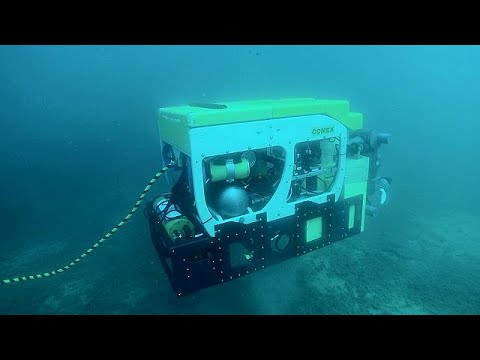This edition of Futuris looks at the new, more intelligent breed of remote-operated vehicles (ROVs) and how they will benefit us.
If an undersea mission is too deep or risky for human divers, researchers can send down an ROV, as we discover in the French city of Marseille.
At the time of our visit, the Janus research vessel was about to leave Marseilles port for a day at sea. It carries a piece of technology often used to observe or manipulate items on the sea floor: a pressure-resistant robotic platform tethered to the ship by a very long cable.
“Humans can’t go beyond a certain depth,” explained Peter Weiss, robotics and automation engineer, Comex.
“If we want to go below 700 metres then we need a robot. That’s when we use the so called ROVs — to perform these kind of deep-sea operations.”
It is extremely rare that divers go deeper than 100 meters deep (which is already very demanding). With particular equipment (atmospheric diving suit) it is possible to go up to 700m deep, but their use is still very experimental, and remains the exception rather than a daily routine.
Departure to the sea
This vessel’s ROV has two cameras which, just like human eyes, provide stereoscopic vision, and with advanced ‘arms’ — the manipulators have three ‘fingers’, so more dexterous than typical two-fingered ROVs.
“There is some room for progress in terms of dexterity when manipulating objects,” explained Jeremi Gancet,” DexROV project coordinator and technologies, applications & research division manager at Space Applications Services.
“We are also working on controlling this kind of robotic platform via satellite link from a control centre that can be placed anywhere in the world.”
Until then, all ROVs need to be controlled from the ship. Moving the control onto land would be safer and more cost-effective, as smaller vessels could be used.
For the test, a ship in the Mediterranean Sea is linked via a satellite to the control centre in Belgium.
Some 1,000 km away, the operators work in a virtual reality simulation. Their commands are relayed back to the ROV. There is a communication delay. So the ROV has to be autonomous enough to operate safely with no real-time control. It also needs intelligence to interpret what’s happening in the virtual world, and to act accordingly in the sea.
”We have separated what the robot does from what the control centre does,” Javier Martínez González, Researcher in virtual reality, Space Applications Services, told Euronews.
“Here the work will be conducted continuously, in real time. The intelligent software will be observing what we’re doing at the control centre and will be sending this information to the robot which will be carrying out the tasks automatically, by itself, without our continuous guidance.”
To make robotic arms more dexterous, engineers in this European research project are using an exoskeleton system. It provides the operator with force feedback, allowing to feel the weight and resistance of the objects manipulated in virtual reality.
”We’ll control this 3D character in virtual reality,” said Pierre Letier, Robotics engineer, Space Applications Services.
“He’ll perform a task, and his movements will be taken apart to be reassembled by the remote robot, which allows to operate with long delays.”
This technology can help to control autonomous vehicles safely and accurately — not just in depths of the ocean, but also on land, or wherever robotic dexterity could be used.
“You can imagine this same kind of technology used on a mobile platform on the ground, with manipulator arms,” said Jeremi Gancet.
“This kind of technology could be useful in dangerous situations such as Fukushima where there’s still the need for operations on the ground.”
The researchers are testing components of their advanced ROV system, heading to a advanced trial 1,300 meters deep in the Mediterranean Sea.





